
Written By:
Sean Henri
So you’ve just created an amazing new ebook that you’ve spent several weeks researching, writing, and illustrating with interesting visuals.
Now what?
If you’re like most marketers, you’ll quickly publish it on your website, share it with your sales team, and then move on to your next project. If you’re feeling particularly proud of your work, perhaps you’ll tweet it out, or slap a call-to-action on the footer of a recent blog post prompting readers to download it.
We call this the “leave it to fate” content promotion strategy, where a piece of content (whether an ebook, blog post, video, or something else) succeeds or fails on its own.
While this can sometimes work, the painful truth is that, most often, it leads to failure.
Most marketers spend far more time creating content than they do getting the word out to promote it. But if you want to have any chance of seeing the results you were expecting to find when you first began creating that content, you need to flip this content/promotion ratio around.
How much effort should marketers devote to promoting their own content? Most of the time, we’d recommend you spend 40% of your time creating content and 60% of your time promoting it.
Take the Guesswork out of Inbound
Receive a customized, detailed Inbound Marketing Strategy for your business.
In this guide, we’ll walk you through a step-by-step process for developing a content promotion plan that produces results. We’ll also share an extensive list of actionable tactics proven to expand your content’s reach and increase traffic. Finally, we’ll teach you how to analyze results, iterate your plan, and improve the effectiveness of your content promotion strategy.
Step 1: Create A Content Promotion Plan
Most marketers invest in content development as a means to attract and retain clearly defined audiences, build brand trust, and ultimately to generate more qualified leads and drive profitable customer acquisition. This means that most content marketing efforts are measured by the volume of visits, leads, and customers they help to generate.
So why is it that a recent study by Content Marketing Institute and Marketing Profs showed that only 20% of B2B Content Marketers rated their overall content marketing approach as “Very Successful”?
The answer may be tied to a lack of clearly defined goals and a documented strategy. According to research by CoSchedule, marketers who set goals were 429% more likely to report success than those who did not.
Here’s how you can define your own goals and develop a documented content promotion plan.
Start with the right goals.
In order for the marketing team to demonstrate the value that it brings to your company or organization, all marketing efforts—not just content creation—should begin with an alignment to business objectives.
You need to know what role each and every piece of content you create is designed to do. Is it designed to generate leads, convert leads into customers, attract links, or something entirely different? How does each of these outcomes tie back to various business objectives?
You also need to understand the relative value of those outcomes. What is a qualified lead worth to your business? What is your average deal size, or customer lifetime value?
Without understanding the goals of the content you are creating and the value that your outcomes offer to your organization, it would be impossible to know how much time to invest in a project, which tactics to pursue, and how you’ll measure success.
Note: If you need help, check out our helpful guide on establishing SMART goals based on business objectives.
Make time for promotion.
In order to keep yourself motivated and on-schedule, it’s important to document your efforts in a way that you can easily reference throughout your campaign, and share with others on your team.
Much like an itinerary reminds travellers what they had intended to do each day of their trip, and a map guides you were you’re going, a content promotion calendar can be an incredibly effective way to keep yourself and your team on the right path.
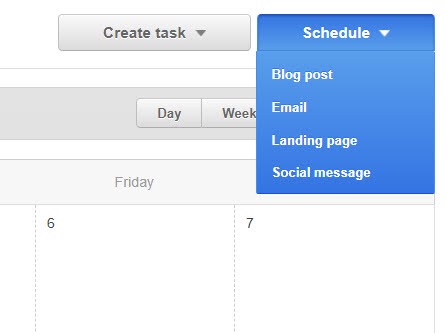
Popular marketing platforms like HubSpot include Calendar tools that allow you to schedule and visualize content like blog posts, emails, and social media messages in bulk for week and even months in advance.
To be useful, your calendar should allow you to filter activities by content type, campaign, or assigned owner.
Segment your audiences for more effective targeting.
It’s common that a single piece of content—whether it’s a blog post, a webinar, or a downloadable template—may need to be positioned in a slightly different way depending on the industry, job title, or persona viewing it. This is called audience or database segmentation, and it’s a marketer’s best friend.
For example, let’s imagine that you have created a downloadable Editorial Calendar Template, and you want to promote it to your full database. While you could send out a single email to all of your contacts, this likely isn’t going to be the best strategy. Why? Because by going after everyone, you limit how targeted you can get in your subject line and email copy—and the less targeted you are, the worse your open rate is going to be.
On the other hand, if you segmented your database into both entry-level marketers and marketing directors, for example, you could then write email subject lines much more targeted to the individual audience.
For the entry-level marketer, your subject line might say something like “Streamline your content marketing efforts.” If you were to send that same email to the Director of Marketing at that company, your subject line might say “Keep your team’s editorial calendar on-schedule.”
Each of these subject lines is tailored to the specific needs and concerns of each segment of your database with an aim of increasing clickthrough and hopefully spurring business.
This is because different segments within your database will value different aspects of your offer. Crafting a different message for each of these audiences can help you maximize how much engagement your various promotional efforts produce. The key here is to knowing what your audience segments are—and what appropriate messaging looks like to each of those segments.
Step 2: Select the Right Mix of Content Promotion Tactics
Once you’ve created your content promotion plan, you’ve got to put in the actual work of promoting your content, which will fall into three broad buckets:
- Organic Promotion
- Paid Promotion
- Experimental Promotion
Organic Promotion
Organic promotion typically refers to the stuff that you’re already doing as a part of your content promotion plan. It’s the search engine optimization, it’s the standard social sharing, it’s the weekly RSS feed emails to your blog subscribers. It’s the stuff that has always worked and which will likely always work—in 2018, 2019, 2020 and beyond.
Paid Promotion
Paid promotion is when you pay money to get your content out in front of an audience. This could take the form of search ads, remarketing ads through the Google Display Network, or ads on social networks like Facebook and LinkedIn. Though paid promotion isn’t as effective as organic promotion, it still likely has a role to play in your content promotion plan—and likely will for the foreseeable future.
Experimental Promotion
Experimental promotion, sometimes referred to as growth “hacks,” are the tactics that you might try to leverage (in addition to the paid and organic promotion discussed above) to push your content over the edge. These are tactics outside of the regular playbook which have the potential for a lot of upside. But there’s no guarantee that they’ll work for all businesses, or for all industries, or at all times. While organic and paid promotion are likely to be around for years and years to come, experimental promotion tactics will often work for a short period of time and then, suddenly, just not work anymore.
While you probably already know how to do organic and paid promotion, the “experimental” bucket has probably piqued your curiosity, and with good reason. Done correctly, these strategies can help you differentiate from your competition and give you a boost while you wait for your content to begin ranking organically. Even if experimental content promotion tactics only make up 10% of your promotion efforts, the potential for upside can be tremendous.
With that in mind, we’ve gathered 37 advanced content promotion tactics that you might want to try to push your content over the edge in 2019.
Note: These are the tactics that we currently see working really well. As time goes on and we find certain tactics stop being effective, we’ll remove them from this list while adding others.
37 Advanced Content Promotion Tactics to Try Today
1. Ask an influencer (or two) for a quote.
This is perhaps one of the most effective ways of giving your content an immediate boost, as it comes with a built in amplification network.
If you have a relationship with influencers within your industry (or who are experts on the subject you are writing about), asking them for a quote and then weaving that quote into your content can go very far in helping your content take flight, for two reasons.
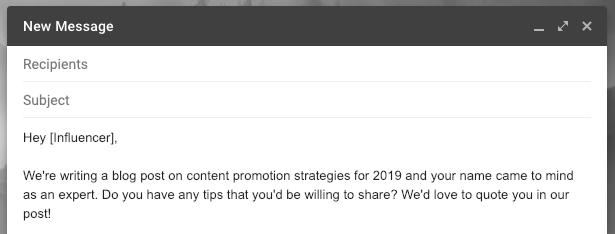
One: If you quote anyone in an article, that person will be extremely likely to share that content to their network. It’s an ego boost for them, after all. Who wouldn’t want to show off that they were quoted in an article or review? If the person you quote is an influential one, all the better, because their network is probably much larger (and more engaged) than the network of an average Joe.
Two: If your content is the primary source of a really interesting quote by an influencer, other publications will be inclined to link to your content if and when they find the quote and choose to weave it into their own content.
2. Mention those experts when sharing your content.
Personalization produces much higher engagement across the board. Tagging, linking, and mentioning key influencers will help you get noticed by others who follow and respect these individuals.
Over time this will help your brand build a reputation and maybe even get them to collaborate with you. But make sure you’re tagging them in a productive manner; don’t just tag them just to tag them. Ideally you should only tag people who you truly think will find the content interesting, or who you’ve leveraged to create the content (for example, by weaving in a quote of theirs into your content).
3. Email your contributors so they comment on, link to, and share your content.
If you’ve created content that makes use of the contributions of others—whether in the form of quotes, images, statistics, or something else—emailing those contributors to tell them that the content is live is an extremely easy step that you can take to promote your content.
If you’re lucky, your contributors will comment, share, and link to your content, acting as a built in amplification network and giving your content an initial boost that can help it get ahead of the competition.
4. Contact your contributors’ fans to let them know about your content.
If you’ve created content that leverages the contributions of others (particularly influencers) you should use that to your advantage. While the best course of action would be for the influencer themselves to share the content to their network, even if they choose not to you may be able to leverage their network of fans.
For example, if you know of a particular forum where fans of your contributor go to discuss relevant topics, try sharing your content within that forum explaining that the contributor was quoted. Or consider contacting top fans of the contributor on your own through social media.
The key to success here will be making sure that you aren’t being spammy with your outreach. That’s a surefire way of getting yourself blocked, which will forever shut you out of a potentially valuable promotion channel. So make sure that anything you share in this way is something that you think will truly be valuable or interesting to the recipient.
5. Contact those who have shared similar content.
By using a tool like BuzzSumo, it’s possible for you to create a list of people who have shared content similar to yours on social media.
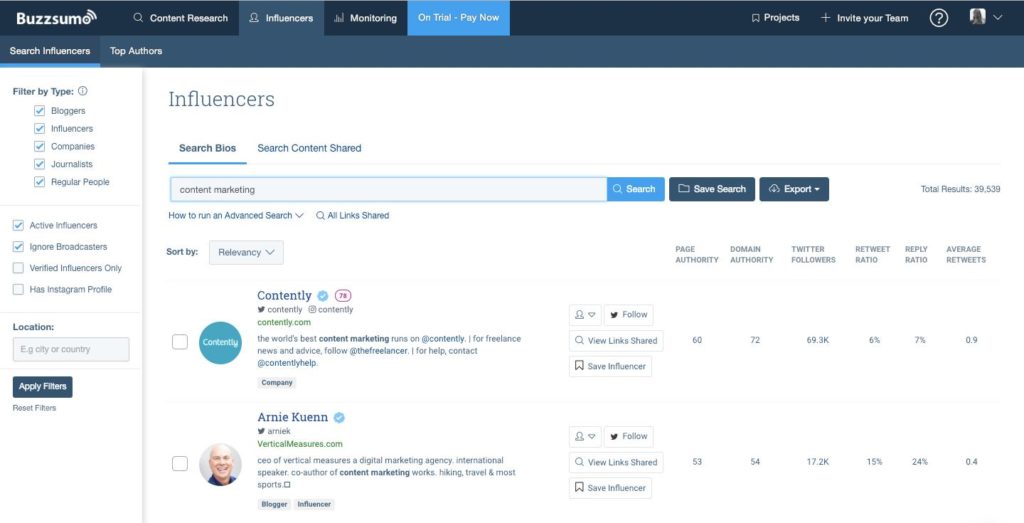
Once you’ve created this list, consider reaching out to them to let them know about your content. If they truly find it interesting, there’s a good chance that they will share it to their network—even without you explicitly asking them to do so.
6. Contact those who have linked to similar content.
Before you even begin to create your content, it’s a good idea for you to conduct some competitive analysis to see what else is already out there. In addition to informing the structure, tone, and other specifics about your content, this can also help you identify good link building opportunities.
As you conduct your research, keep an eye out for any websites you find linking to your competitors’ content. Keep those websites as a list (along with their contact information, if you can find it) and, once you’ve finished creating your content, reach out to the publications linking to your competitors. While there’s a fine line to walk here to avoid coming across as spammy, as long as your content shows real value, it’s very possible that they will link to you.
7. Contact your mega-fans to encourage them to share, link to, and comment on your content.
Nearly every brand has a select group of people who simply love every piece of content that they create. These could be social media followers who are consistently engaged, other websites who regularly link to your content, or anyone else who appreciates the work you do. We call these “mega-fans” or “cheerleaders,” and you shouldn’t be afraid to leverage them.
Whenever you put out new content that you think your mega-fans will appreciate, you should contact them (whether by email or social media) and encourage them to share, link to, and comment on your content.
One thing to keep in mind: When reaching out to your cheerleaders to share this new content, it’s really important that you don’t alienate them by making them feel used or sold to. An easy way to do this is to avoid sending them bulk emails/outreach and instead send them a personal note.
8. Contact relevant associations and/or groups to let them know about your new content.
If you’ve created a resource that you think may be of value to a particular association or interest group, you should absolutely reach out to them to let them know about your new resource. The key to success here is ensuring that your content is actually helpful to the members of the organization that you are targeting. If it is, you’ve given the organization an easy way to bring value to their members, and they’re absolutely going to take advantage of that.
In the best case scenario, they may include a link to your content on the “Member Resources” page of their website; in the worst case scenario, it’s almost a given that they will at least blast your content out on their social media channels. From there, you’re bound to get more views, more sharing, and potentially more links.
9. Invite relevant associations/groups to collaborate on (or “sponsor”) your content.
On a related note, if the content that you are creating speaks to a particular industry, you should see if there are any associations who might want to form a partnership around that content.
This partnership could take a number of forms, including:
- The association simply “sponsoring” your content by putting their name on it
- The association actually helping to create pieces of that content
- The association providing quotes for you to use in the content
- The association providing interesting statistics, facts, or insights to use in the content
This doesn’t just make it easier for you to create the content. It also brings a built-in promotional network to your resource, because once it’s complete, the association is bound to link to it and share it to their social networks.
10. Survey your customers or existing contacts for interesting data you can use to create your content with you.
Weaving interesting data into your content is a surefire way to encourage others to share it and link to it—especially if you’re the primary source (i.e., the person who created it) and especially if the data is shocking for surprising.
Just because you don’t have the budget for a large-scale, national survey doesn’t mean that you can’t give this tactic a try. Instead of turning to a third party service or research organization, just leverage your existing customers or contacts. There are tons of free survey tools that you can use (like Hotjar, for example) to gather the data.
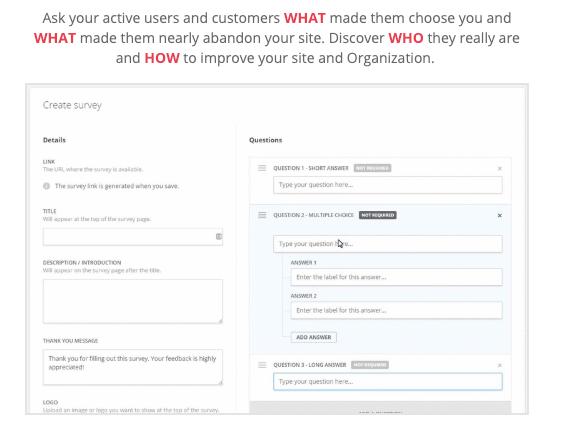
11. Leverage HARO to find journalists who need authoritative sources.
If you want other websites to link to your content—and you definitely want them to!—then you need to find a way to bring value to those websites. One way that you can do just that is by becoming a source for reporters. If you can answer a question that a reporter needs answered in order to finish their assignment, they’re going to link to your website when they give you credit, and they might even link to a specific piece of content if you can show that it would be a valuable addition to their piece.
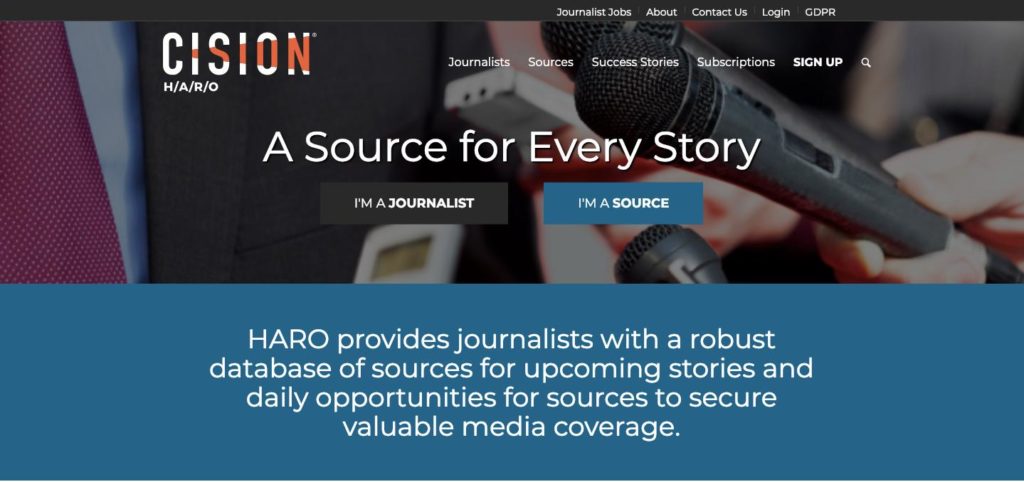
One way that you can do this is by signing up with Help a Reporter Out (HARO), a free service run by Cision. It works like this:
- You sign up to become a source, and select the subject areas you’re interested in possibly contributing to
- Three times a day (once in the morning, afternoon, and evening) you will receive any questions that have been submitted from reporters
- If you see one that you can answer, you can do so by email
You should keep in mind that reporters are often working on extremely tight deadlines, and the sources who provide the most complete answers the fastest are often the ones who ultimately are used as a source. Also, don’t forget to tell the reporter who you are: Include your name, credentials, and a link to your website with your response!
Once you’ve found someone who likes your input and who is willing to link to your content/website, you should be sure to nurture that relationship; it’ll come in handy in the future.
12. Seek journalists’ input before you create content to verify they’ll share your resource after you’ve created it.
This one is important. If you’re going to spend time, effort, and potentially money to create a piece of content, then you need to make sure that it is going to be able to attract links; otherwise, it isn’t likely to rank on the first page of search results (unless the current competition is poor). To attract links, your content needs to be helpful to the reader.
How do you do this? First create an outline of the content that you are thinking about creating. Then compile a list of journalists who regularly write about the subject in question, and reach out to them, sharing your outline. Ask them if this is content that they think they would find valuable once it is done.
If so, you have a winner (and the names of people who might leverage your content once it’s complete). If not, you should revise your content outline so that it is more likely to be useful to these journalists. Ask them what would make it more helpful, and build those components into the plan.
13. Drop a special “personal note” to your blog subscribers.
Reaching out to your audience without asking them to do something, sign up for an offer, or read a blog can make them feel connected to your brand. In today’s world, very few companies have a “human-side” people relate too.
Sending out an email just to say “thanks” or a “quick hello” may increase your customer engagement. Allowing for a free conversation that isn’t focused on buying or selling helps build a relationship to better serve your audience in the long run.
14. Email the “cool” leads on your backburner list to warm them back up.
If you’ve created a piece of content that you truly think is interesting or valuable, then you should put it to use every way that you can. One great way to do this is by sending the content to the contacts in your database who are cool, but not cold—contacts who check out a blog post every so often or open maybe one email out of every three, but who have yet to convert into customers.
Best case scenario, this new piece of content might be just the thing to finally get them to convert. Worst case, they simply stay unengaged until warming back up later (or being purged in the future).
15. Share on social media (multiple times).
Social sharing should already be a built-in part of your promotion strategy. But you can’t just share your content once and expect that to be enough: You should share the content across all of your channels, multiple times.
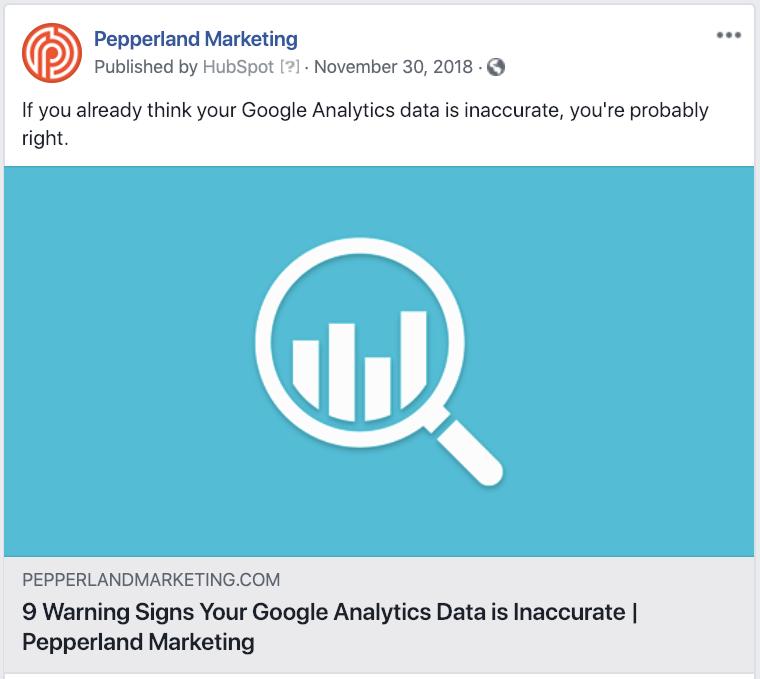
The exact cadence of this sharing will depend on your content and on your audience, but often it will look something like this:
- 3 shares on each of your networks the week that the content is published
- 1 share per week on each network thereafter while the content is fresh
- Occasional ongoing posting as your content continues to age
16. Ditch headlines and share interesting quotes instead.
Want to increase your social engagement when you do share your content? Of course you do! Well, the secret to increasing your social engagement could be as simple as rethinking how you position each of your posts.
Though sharing headlines is easy, you’re more likely to get a reader to click through to the actual article (and share it on their end) if you share an interesting quote or insight from within the content. Structuring your social shares around the insights and quotes that are likely to pique the interest of the people in your network is one of the easiest tweaks that you can make to make your social strategy more effective.
17. Pin interesting quotes to Instagram highlights.
You can create an interesting image and ‘pin’ it to your Instagram by using the highlight feature. Once you add it to your highlights, it will stay in the top section of your profile. Keeping these important posts at the top will hopefully get anyone checking out your profile to click on them.
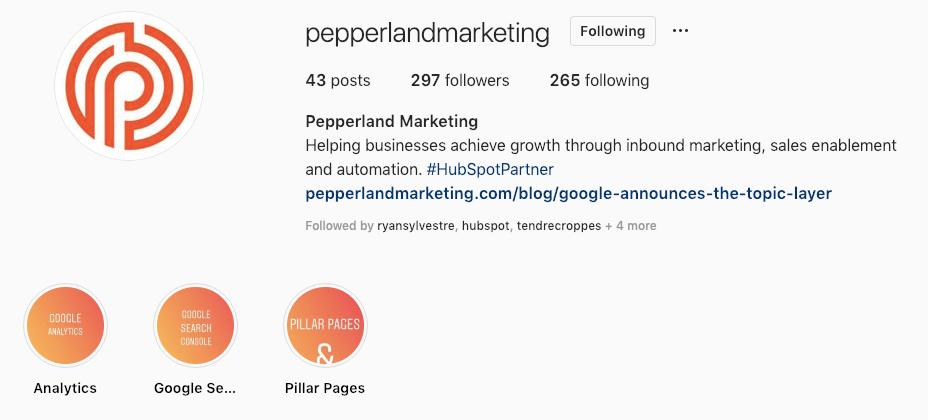
One of the easiest ways to create an eye-catching quote image for Instagram is to build it out in Adobe Spark. You can create images for a traditional image, or for an Instagram story. You can easily switch text, color, and icons to best match your brand.
18. Create an Instagram (or Facebook) story for each sub-headline within your content.
If you’ve created a piece of content like a blog post and you have an engaged following on Instagram or Facebook, put that content to use on the social networks.
One popular way of doing this, especially for fresh content, is to create a story for each subhead of your content, with a prompt to read the full article and share. Depending on how engaged your social following, this simple act of repackaging your content into bite-sized snippets can have tremendous returns.
19. Package up key takeaways as a Twitter moment.
Twitter moments have been around for some time now. They are a compilation of important tweets packaged up for maximum engagement. We ran a test on our own content and saw a noticeable increase in engagements when posting a twitter moment.
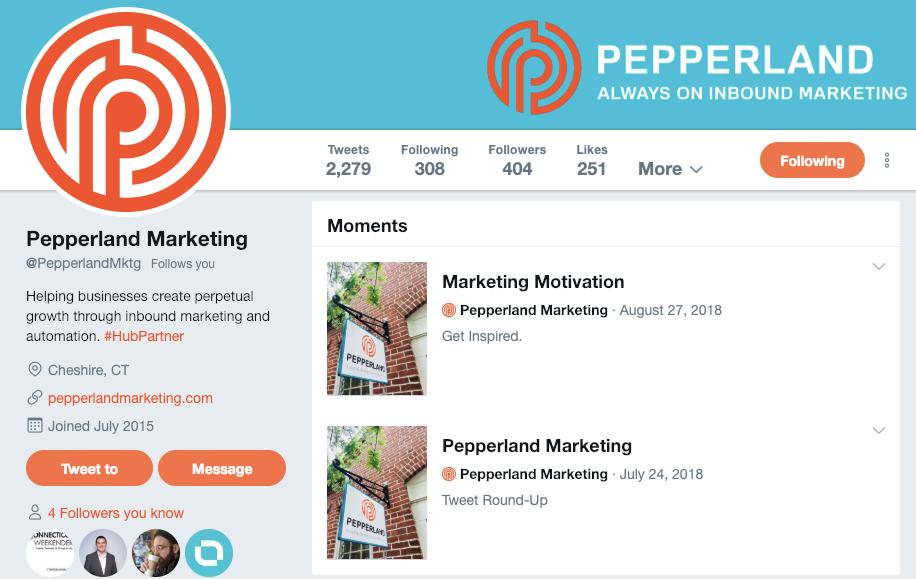
You can easily make a moment from your “Moments Tab”. Just title your post and give a short description, pick the tweets you want to feature and voila! This package of tweets will grab your followers’ attention because it looks unique in their feed and most likely grab some attention.
20. Host an informal Facebook Live Q&A session.
When it comes to content creation, you can use Facebook Live Q&A sessions in two ways.
First, you can host a Q&A before you create the content, so that you can get some insight into the kinds of questions your network has—which will allow you to weave those questions into your content and increase the chances that it will perform well.
Then, after you’ve created your content, you can host another Q&A about the same subject as what your content is about. While you should answer as many questions as you can during the time you’re live, you can also use that time to direct your viewers to your content (and other helpful resources).
21. Repackage your content as an infographic.
Pick a blog post or a series of blog posts that you can turn into a cool infographic. Creating something eye-catching can urge your audience to download and share your image. Let’s face it, people are going to be drawn to these graphics because they are easily digestible.
If you create an infographic that solves a common pain point people can download it, share it on social, or print it out and share it around the office. It may take some time to go through the process of creating one, but the potential ROI is huge.
22. Repackage your content as a well-designed slideshare.
The thinking behind this one is the same as it is for repackaging your content as an infographic: Some people are more inclined to consume content when it is presented to them in a visual way. Because of the visual nature that slideshares tend to take, this makes them an ideal vehicle for explaining complicated subjects and ideas.
The best part? Slideshares themselves have the potential to rank for valuable keywords, doubling the chances of your content performing well—without you having to do too much extra work.
23. Distribute your content on YouTube to rank well on the world’s second largest search engine.
When most people think about getting their content to rank, they instinctively think about Google, which makes sense: It is the world’s largest search engine, after all. But focusing purely on Google means missing out on the second-largest search engine: YouTube.
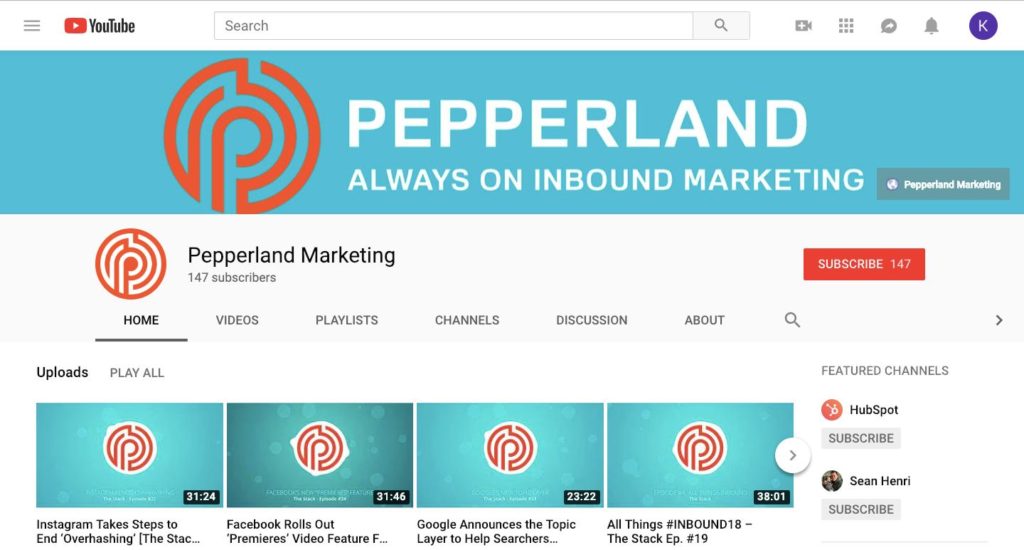
By repackaging your content in video format, you can get it in front of those searchers who turn to YouTube first, instantly increasing your content’s reach and attract visitors. Plus, you then have a video that you can weave into your social promotion strategy and the content itself, boosting your ability to rank.
The key to success is ensuring that watchers have a path back to your website. YouTube makes this relatively easy to do with its video overlay features, but you should also be sure to include a link to your content in the description of your video so that interested viewers can click through and learn more.
24. Leverage paid ads to amplify your social promotion.
While it’s nice when your content performs well organically online and through social media, it isn’t always guaranteed. It can take week, months, and even years for a piece of high-quality content to accrue the links and authority that it needs to rank well. While this is a noble goal, it doesn’t exactly offer the quickest return on investment.
That’s why you should leverage paid ads to amplify all of your content—even if you’re following an inbound gameplan. These ads can help your content perform as though it was already ranking well, giving it a head start against the competition so that you begin accruing links that will help you rank organically over time as your content ages. It also has the potential to give you a much faster return on your investment, making your key stakeholders happy.
25. Send your employees pre-written social media posts to share.
Your company or organization has its own social channels with which you promote your content. But an easy way to instantly increase the reach of your content is to encourage your employees to share the content on their individual social accounts—especially if they are active in the industry, interact with your potential buyers, or have substantial networks.
The easiest way to get your employees to do this? Each time you create a piece of content, block off some time to draft some pre-written posts, and send those to your employees when encouraging them to share. It’s almost like you’ve done it for them!
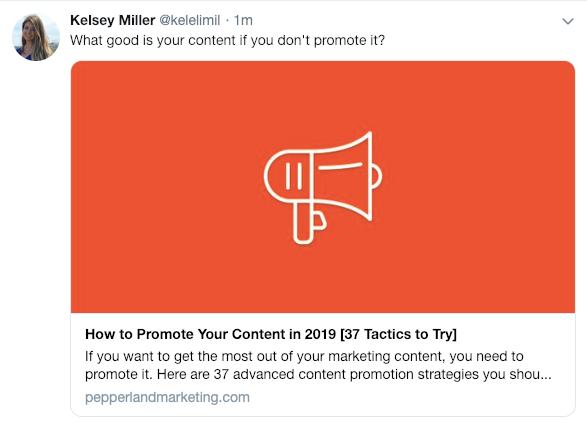
26. Submit your content to relevant communities and forums.
While success in organic search is the key to long-lasting return on investment for your content, it isn’t the only channel available to you. Delivering your content to readers you know (or suspect) will be interested in it is another potentially powerful tactic to try. Just as you might email your content to contacts in your database who’ve expressed interest in the subject in the past, you should also be sure to leverage any relevant online communities and forums.
If there is a particular forum that you know your target audience reads, or an online community where you know questions about your area of expertise are asked, consider becoming a part of that community. Participate in the discussions, offer your thoughts and recommendations, and when it makes sense, link to your content. Just be aware of the rules of posting (most forums prohibit spammy posters) so that you don’t anger the community members and inadvertently turn them off from your brand.
27. Create topic clusters of related content that link to your primary resource.
If the content that you’ve created is a substantial one which has the potential to act as a pillar page for your business, then one of the single best steps you can take to improve its performance is to link to it from other content—whether this content already exists or it needs to be created. Doing so will make it easier for users and search engines to find your content, helping it get shared and linked to more easily.
Even if your content is just a blog post (and not a more comprehensive pillar page or ebook) you should be sure to find opportunities to link to it from related content that already exists on your website.
28. Create a group of “beta readers” who can provide you with input before you go live, and who will be inclined to promote your content once you’ve published it.
For content to be successful, it often has to help a user either solve a problem or reach a goal. That’s why many marketers (including us) write out user stories to determine what problem a searcher is likely to be trying to solve when they do a certain Google search. If we’re able to effectively solve that problem better than anyone else, there’s a very good chance that we will outrank the competition.
But how can you be sure that your content actually solves the problem that you set out to solve?
The easiest way is to actually test it by putting it in front of readers before the content officially goes live. Ask them for their input and opinions, and use it to make your content stronger. Then, once the content is actually out there in the wild, encourage these beta readers to share and link to it. Because they played a role in creating it, they’re much more likely to oblige.
29. Submit your custom tools and resources to Product Hunt.
Product Hunt is an online forum and community where product creators can post their content to spread the word about it. Others then rank the product and comment on it, with the most popular products bubbling up to the top.
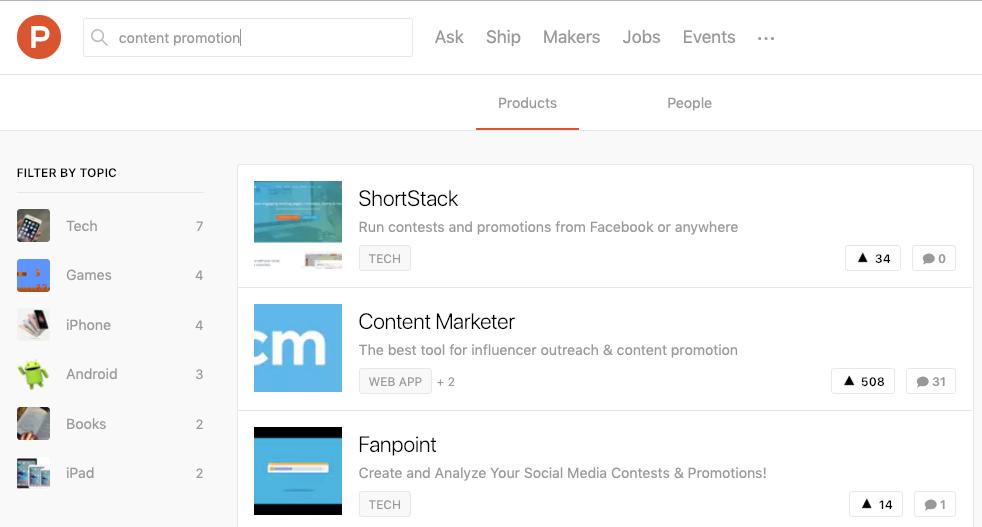
In order to do well on Product Hunt, your content can’t just be content. It should also function in one way or another as a tool. For example, you wouldn’t submit a blog post to Product Hunt—but you might submit a calculator, template, app, or other tool that you’ve created as a part of your company’s marketing efforts.
30. Leverage remarketing/retargeting ads to nudge first-time visitors to convert.
Remarketing ads can be some of the most effective available to marketers, for a simple reason: The person viewing the ad has already been on your site, implying that they may value your content in the future.
If you’ve created a piece of high-value content that has the potential to convert visitors into leads, consider supporting it with remarketing ads that will serve it up to those visitors who have already been on your site in the past but who haven’t identified themselves. This could be just what those visitors need to finally convert, and has the potential to help you squeeze the absolute most value out of the content you create.
31. Incorporate your content in automated lead nurturing workflows.
If you have some high performing top of the funnel content, you can use this to turn new leads into customers. If you notice that most of your customers landed on the same pages before becoming customers it’s likely that you can recreate the process without putting a ton of effort into it.
You can create an automated email workflow that enrolls anyone that fills out a form into this process. Set up your workflow with your lifecycle process in mind. Make sure you take into account the content related to each stage and how long it takes to move into the next step.
32. Require your content as “required reading” during your customer onboarding process.
If you’ve got a vast library of content at your disposal, it’s a mistake for you not to leverage that content in your sales process. Even after a sales has been closed, your content has a role to play during customer onboarding. Use the information that you know about a contact (for example, their purchase history) to curate content that you believe they’d find interesting or helpful, and send it to them directly in an email or thank you page.
By helping your customer get more joy and value out of your product, you build trust with them even after the sales process has ended, potentially encouraging them to return to do more business with you in the future. All you have to do is put the content you’ve already created to use. What could be easier?
33. Lace your content with “tweetable” quotes to encourage sharing.
People are lazy. The more steps that it takes us to complete an action, the less likely we are to actually complete it—especially if we view the payoff of the action as being relatively low value.
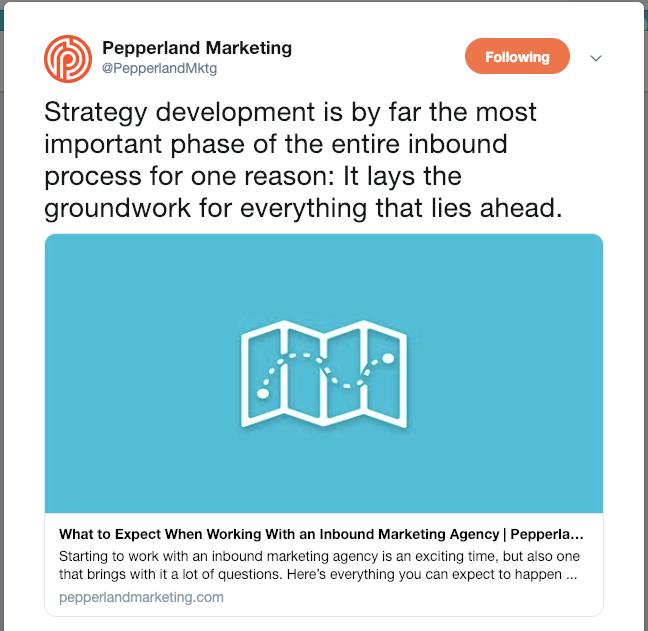
Content marketers who want to encourage their readers to take the action of sharing their content can take one of two options to get around this fact. You can either create content that is so gosh darn amazing that the reader doesn’t mind taking a few extra seconds to share it to their network, or make the act of sharing your content as easy and streamlined as possible. (Ideally, you’d be doing both.)
Okay, so you know how to create better content. But how can you make it easier for your readers to share it? Simple: Just identify the 2-3 most interesting sentences or takeaways from your content and sprinkle them throughout your content in the form of tweetable quotes. That way, when your reader sees the interesting thing, all they need to do is push a button to share it to their followers, immediately giving you even greater reach.
Easy peasy.
34. Embed your content with linkable statistics and takeaways to help build up your backlink profile.
If you’re creating content with the hopes of attracting links from other websites, then you need to make sure that your content is worth linking to. Addressing a topic from a new or interesting angle is one way that you can do this, but it obviously takes a lot of work.
Another way is to make sure that the content you create weaves in resources that other content creators will find helpful and valuable. Things like quotes, statistics, and interesting takeaways—the same stuff that you are likely looking for when you create content yourself.
While weaving in third-party quotes or statistics can be valuable in and of itself, you’re likely to see the most value from this tactic if you are able to act as the primary source of a given fact, stat, or quote, because this means that the other publication has to link to you if they want to be taken seriously. So when possible, think of ways that you can create your own interesting statistics (maybe by surveying your customers or analyzing your proprietary data) and use those stats in your content.
35. Answer questions related to your topic on Quora (and other platforms).
Before you create content around a certain subject or topic, do some research to identify what, if any, questions people are asking about that topic, and weave answers to those questions into your content as you create it. (Answer the Public is a particularly helpful tool that can help you identify these questions.) Then, after you’ve created your content, go out and find people who are asking these questions on Quora or other crowdsourcing platforms, and use your content to answer their question.
This helps you achieve two things. First, it gets your content in front of an audience that you know are interested in it (because they’re asking questions about it). But more importantly: Many Quora posts rank well for question-related searches, potentially giving you another opportunity to rank.
36. Find related content on external sites that would benefit by linking to your content.
If you’ve created an excellent piece of content that you truly believe another website would find beneficial (to either themselves or their network) then you should let them know. In a best-case scenario, they’ll link to it and may even share it through their social channels, helping improve your link profile so that your content (and website overall) ranks better in search. Worst case scenario? They’ll say no, or just ignore you.
Caveat here: Link-building can be incredibly challenging. Someone is simply more likely to link to your content if they find it organically and take value out of it, as opposed to if you reach out to them asking them to link to it. That being said, you can increase the likelihood of success with a few relatively simple tips:
- Make sure you’re reaching out to the right person at a company.
- Make sure that your content is actually relevant and valuable to them.
- Consider positioning your content as something they “might find helpful” or “might find interesting,” without directly asking them to ink to it. If they agree with you, they’ll link to it on their own.
37. Republish your content with an alternate headline on Medium.
If you want your content to perform well, you need to get it in front of the people who are going to find value in it. Some of those people will find your content through social media. Some will search online forums. Some will rely primarily on Google. Then there are others—as many as 60 million each and every month as of 2016—who find their information (or at least a portion of it) on Medium.
While this is nowhere near the volume of traffic that Google or Facebook generate for their users, 60 million is nothing to sneeze at. And the best part is that it’s a relatively easy channel for marketers to take advantage of. Simply republish your content on Medium with an alternate headline, set the original post or page as the canonical, and boom, your content has the potential to reach millions of people, all while funneling traffic and authority back to your website. Where’s the downside?
Putting It All Together
By putting just as much emphasis on the promotion of your content as you do creating it, you’ll find you’ll reach more readers, prospects, and customers than ever before. All it takes is 1.) a plan, 2.) a willingness to experiment with new tactics, and 3.) a formal process for analyzing and sharing results with others on your team.
What is your favorite content promotion strategy or tactic? Which suggestions on this list have you tried? Any you disagree with? Contact us anytime!








